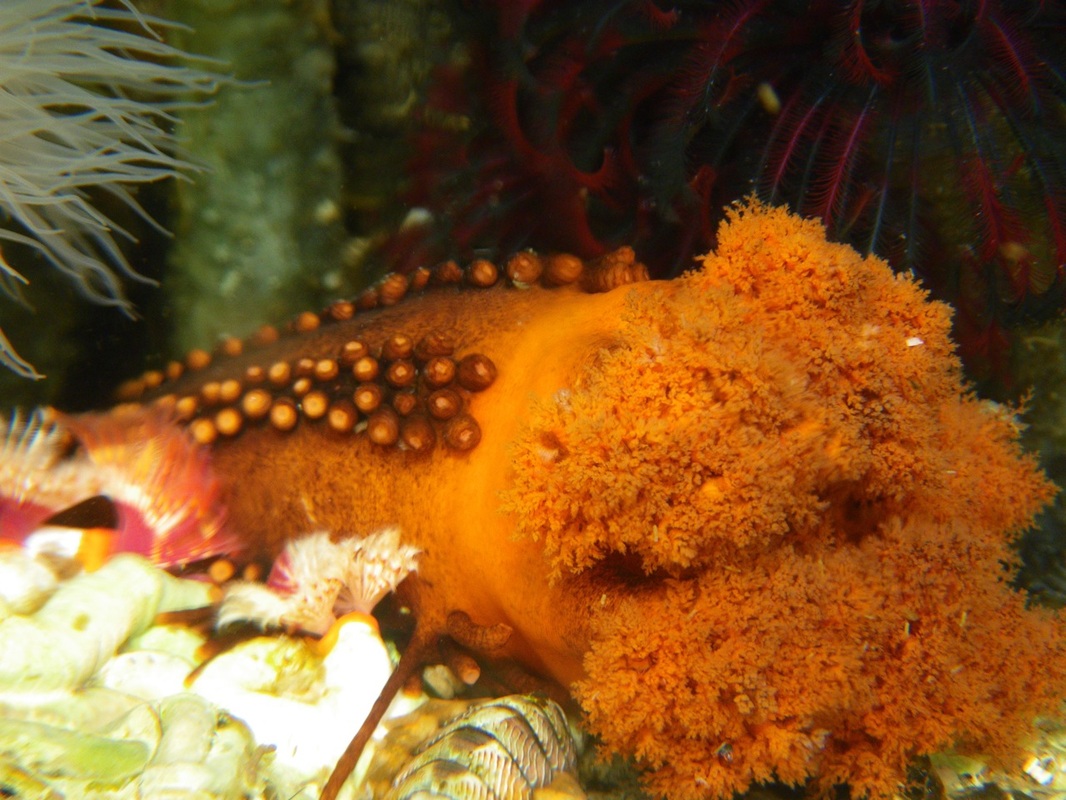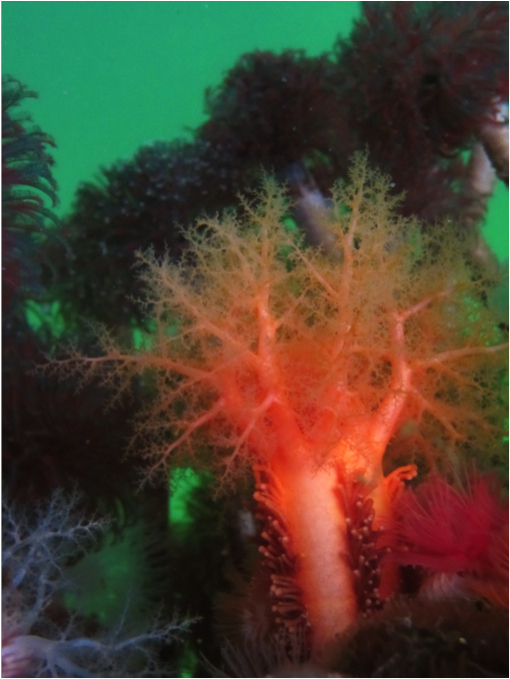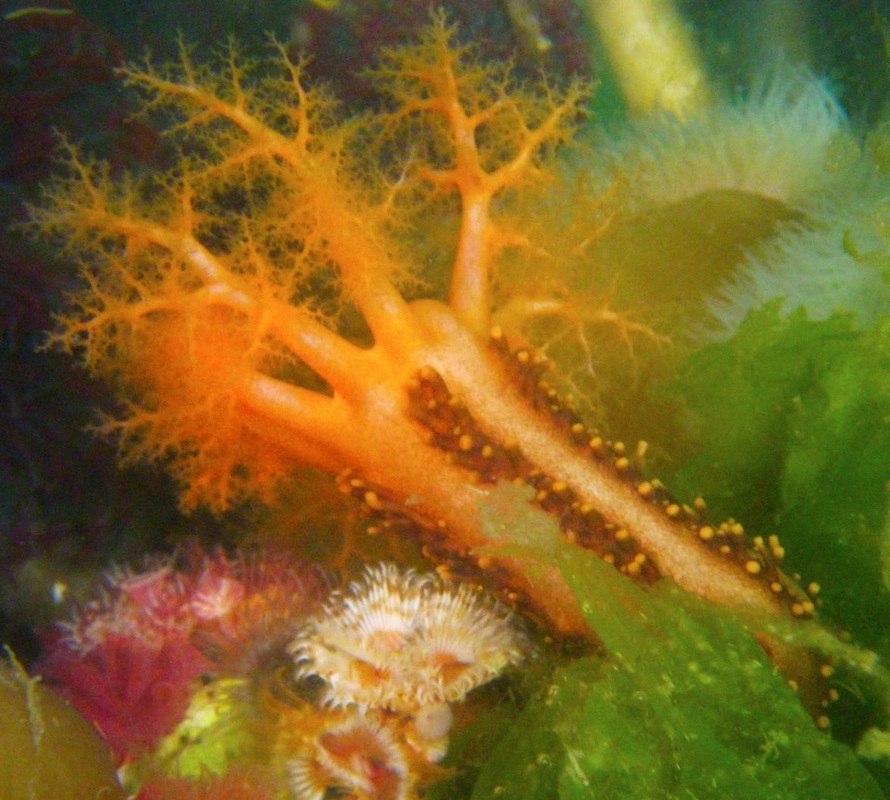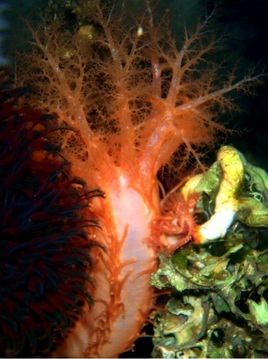Orange sea cucumber, red sea cucumber, vermilion sea cucumber, red sea gherkin • Cucumaria miniata
{miniata = bright red}
Identification
The orange sea cucumber varies in colour from reddish brown to pinkish brown, and occasionally may be pinkish-white. Its elongated body is 10-25 cm long and bears 5 rows of brown tube feet along its length. Ten finely-branched, bushy bright orange to orange-red tentacles extend from one end of the body. These tentacles may be the only visible part of the animal, as the rest of the body is often hidden in a crevice or under rocks. A sea cucumber out of water, without its tentacles extended, can appear quite different from one in water and safely wedged between rocks.
Habitat & Range
This sea cucumber can be found wedged between or under rocks or other shelter, with its tentacles exposed and extended. It lives from the low intertidal to 225 m deep and is most abundant and common in areas with currents. Its range extends from the Aleutian Islands to northern Mexico.
Intriguing Info
The orange sea cucumber is a suspension feeder: it uses its extended oral tentacles to catch plankton and detritus, and then draws the tentacles into its mouth one at a time to ingest the food. It is preyed on by the leather star (Dermasterias imbricata) and other sea stars. Learn more about orange sea cucumber biology on the E-Fauna species page.
The orange sea cucumber varies in colour from reddish brown to pinkish brown, and occasionally may be pinkish-white. Its elongated body is 10-25 cm long and bears 5 rows of brown tube feet along its length. Ten finely-branched, bushy bright orange to orange-red tentacles extend from one end of the body. These tentacles may be the only visible part of the animal, as the rest of the body is often hidden in a crevice or under rocks. A sea cucumber out of water, without its tentacles extended, can appear quite different from one in water and safely wedged between rocks.
Habitat & Range
This sea cucumber can be found wedged between or under rocks or other shelter, with its tentacles exposed and extended. It lives from the low intertidal to 225 m deep and is most abundant and common in areas with currents. Its range extends from the Aleutian Islands to northern Mexico.
Intriguing Info
The orange sea cucumber is a suspension feeder: it uses its extended oral tentacles to catch plankton and detritus, and then draws the tentacles into its mouth one at a time to ingest the food. It is preyed on by the leather star (Dermasterias imbricata) and other sea stars. Learn more about orange sea cucumber biology on the E-Fauna species page.
References
Adams, M.J. (2005). Cucumaria miniata (Red sea cucumber). Beach Watchers. Washington State University. Accessed 12/11/2014.
Harbo, R. M. (2011). Whelks to whales: Coastal marine life of the Pacific Northwest [revised]. Madeira Park, BC: Harbour Publishing. P. 184.
Lamb, A., and Hanby, B. (2005). Marine Life of the Pacific Northwest [electronic version]. Madeira Park, BC: Harbour Publishing.
Lambert, P. Cucumaria miniata (Brandt, 1835). In Klinkenberg, Brian. (Ed.) E-Fauna BC: Electronic Atlas of the Fauna of British Columbia. Lab for Advanced Spatial Analysis, Department of Geography, University of British Columbia, Vancouver. Accessed 12/11/2014.
Williams, K., Helmstetler, H., Cowles, D. (2005). Cucumaria miniata (Brandt, 1835). Invertebrates of the Salish Sea. Rosario Beach Marine Laboratory. Accessed 12/11/2014.
Authors and editors of page
Kelly Fretwell and Brian Starzomski (2014).
Adams, M.J. (2005). Cucumaria miniata (Red sea cucumber). Beach Watchers. Washington State University. Accessed 12/11/2014.
Harbo, R. M. (2011). Whelks to whales: Coastal marine life of the Pacific Northwest [revised]. Madeira Park, BC: Harbour Publishing. P. 184.
Lamb, A., and Hanby, B. (2005). Marine Life of the Pacific Northwest [electronic version]. Madeira Park, BC: Harbour Publishing.
Lambert, P. Cucumaria miniata (Brandt, 1835). In Klinkenberg, Brian. (Ed.) E-Fauna BC: Electronic Atlas of the Fauna of British Columbia. Lab for Advanced Spatial Analysis, Department of Geography, University of British Columbia, Vancouver. Accessed 12/11/2014.
Williams, K., Helmstetler, H., Cowles, D. (2005). Cucumaria miniata (Brandt, 1835). Invertebrates of the Salish Sea. Rosario Beach Marine Laboratory. Accessed 12/11/2014.
Authors and editors of page
Kelly Fretwell and Brian Starzomski (2014).







